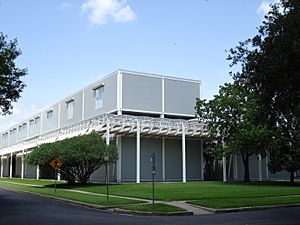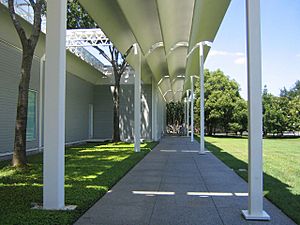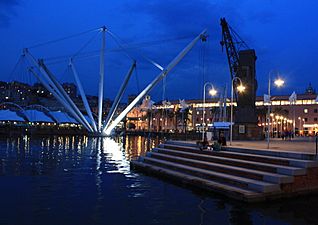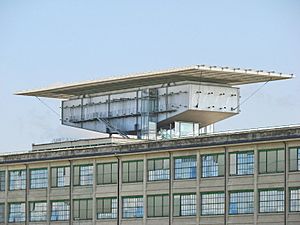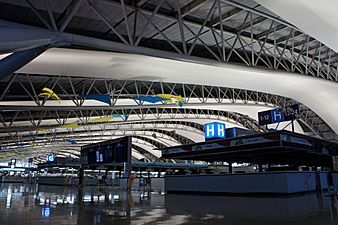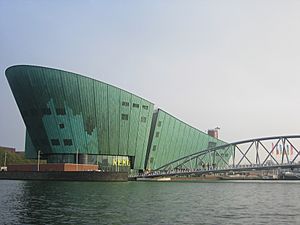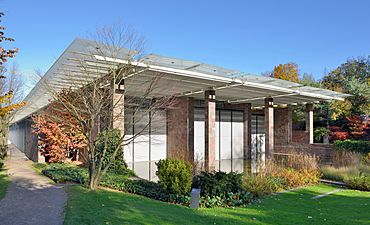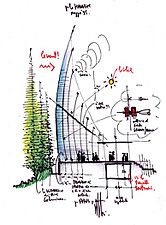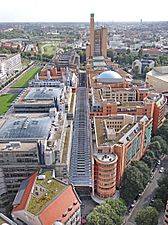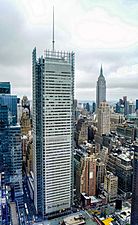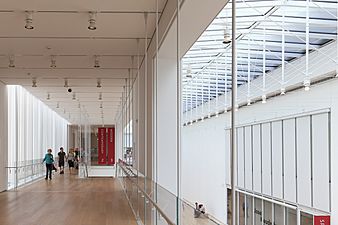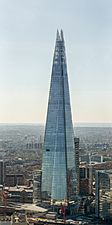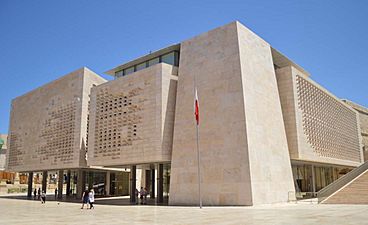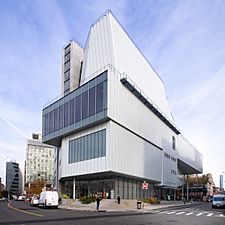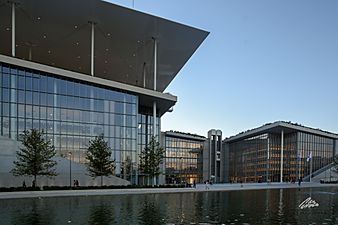Renzo Piano facts for kids
{{Infobox officeholder | honorific_prefix = Senator for life | name = Renzo Piano | honorific_suffix = OMRI | image = Renzo Piano, portrait.jpg | image_size = 200px | caption = Piano in 2012 | office = Member of the Senate of the Republic | termlabel = Life tenure | term_start = 30 August 2013 | term_end = | appointer = Giorgio Napolitano | alma_mater = University of Florence
Polytechnic University of Milan | birth_date = 14 September 1937 | birth_place = Genoa, Kingdom of Italy | party = Independent
| module =
Quick facts for kids
Renzo Piano
|
|
|---|---|
| Occupation | Architect |
| Awards | Pritzker Architecture Prize RIBA Gold Medal Sonning Prize AIA Gold Medal Kyoto Prize |
| Buildings | Kansai International Airport Centre Georges Pompidou Parco della Musica Shard London Bridge The New York Times Building Whitney Museum of American Art Los Angeles County Museum of Art |
Renzo Piano (born 14 September 1937) is a world-famous Italian architect. He is known for designing unique and innovative buildings. Some of his most famous works include the Centre Georges Pompidou in Paris, The Shard in London, and the Whitney Museum of American Art in New York City.
Piano's designs often use glass and steel to create bright, open spaces. He is a master of using natural light in his buildings. In 1998, he won the Pritzker Architecture Prize, which is like the Nobel Prize for architects. In 2013, he was made a senator for life in the Italian Senate, a special honor for his service to the country.
Early Life and Career
Renzo Piano was born in Genoa, Italy, into a family of builders. His grandfather, father, and uncles all worked in the construction business. Their company built houses and factories after World War II.
Instead of joining the family business right away, Renzo decided to study architecture. He went to the University of Florence and the Polytechnic University of Milan. After graduating in 1964, he began to experiment with lightweight structures.
Piano worked for famous architect Louis Kahn in Philadelphia and engineer Zygmunt Makowski in London. These experiences helped him develop his skills. In 1970, he designed the Pavilion of Italian Industry for Expo 70 in Osaka, Japan. This lightweight building made of steel and polyester was a big success.
Famous Buildings and Projects
Piano has designed many incredible buildings around the world. His style is known for being modern, creative, and often surprising.
-
Centre Georges Pompidou in Paris (1971–1977)
-
The Menil Collection in Houston, Texas (1982–1987)
-
Sunscreens of the Menil Collection (1982–1987)
-
The Biosphere in the Old Port of Genoa (1985–2001)
-
Giant "Crane" in the Old Port of Genoa (1985–2001)
Centre Pompidou: An Inside-Out Building
In 1971, Piano and his partner Richard Rogers won a competition to design a new modern art museum in Paris. Their design for the Centre Georges Pompidou shocked the world. They put all the building's functional parts—like pipes, air ducts, and escalators—on the outside.
These parts were painted in bright colors, making the building look like a giant, playful machine. The escalator, enclosed in a clear tube, runs up the front of the building. The Centre Pompidou was a huge success and made Piano famous.
The Menil Collection: Master of Light
In contrast to the Pompidou, the Menil Collection art museum in Houston, Texas, is calm and simple. The main goal was to light the art with natural sunlight. Piano designed a special roof with high-tech shutters that control the intense Texas sun. This protects the art while making the galleries feel bright and open. The building shows how Piano uses technology in a quiet, elegant way.
Transforming Old Spaces
Piano is also skilled at giving old industrial sites new life. In his hometown of Genoa, he transformed the old port into a vibrant cultural center. He added a library, an aquarium, and a giant crane that lifts visitors for a view of the harbor.
He also converted the historic Fiat factory in Turin. He kept the main building, including its famous car test track on the roof. But he added new features like a concert hall, a helicopter pad, and a glass dome conference center.
-
Kansai International Airport, Osaka, Japan (1991–1994)
-
Fondation Beyeler, in Basel, Switzerland (1991–1997)
-
Drawing by Piano for the Jean-Marie Tjibaou Cultural Centre (1991–1998)
-
Jean-Marie Tjibaou Cultural Centre in Nouméa, New Caledonia (1991–1998)
-
Potsdamer Platz Berlin project (Piano buildings on right)
-
Aurora Place in Sydney (1996–2000)
Kansai International Airport
In 1988, Piano won a competition to design a new airport on a man-made island in Osaka, Japan. The Kansai International Airport terminal is very long, about 1.7 kilometers. Its low, curved roof is covered in 82,000 stainless steel panels. The building is designed to withstand earthquakes, with special joints that absorb movement.
Jean-Marie Tjibaou Cultural Centre
This project in New Caledonia is one of Piano's most unusual works. It was built to celebrate the culture of the native Kanak people. The design combines modern materials like glass and aluminum with traditional wood. The building features tall, curved wooden structures inspired by Kanak huts. These structures protect the buildings inside from the wind while letting in sunlight.
21st-Century Landmarks
Piano continued to create amazing buildings all over the globe in the 2000s and beyond.
-
The New York Times Building in New York City (2000–2007)
-
California Academy of Sciences in San Francisco (2000–2008)
-
Modern wing of the Art Institute of Chicago (2000–2009)
-
The Shard, London, UK (2012)
-
Parliament House in Valletta, Malta (2011–2015)
-
Whitney Museum of American Art, New York City (2007–2015)
The New York Times Building
Piano's design for the New York Times Building in Manhattan was chosen to be as open and transparent as possible. The tower is covered in a "curtain wall" of clear glass and ceramic tubes. This screen acts like a sunscreen for the building, saving energy on air conditioning.
California Academy of Sciences
After an earthquake damaged the old museum, Piano was hired to rebuild the California Academy of Sciences in San Francisco. His design placed a "living roof" on top of the building, covered with native plants. The roof helps to insulate the building and blends in with the surrounding Golden Gate Park.
The Shard
The Shard in London was Europe's tallest skyscraper when it was completed in 2012. It stands 305 meters (1,001 feet) tall. Piano designed it to look like a shard of glass, with a pointed top that seems to disappear into the sky. The building contains offices, a hotel, apartments, and restaurants.
Whitney Museum of American Art
In 2015, Piano designed the new home for the Whitney Museum of American Art in New York City. The building has an industrial look that fits its neighborhood near the High Line park. It features both indoor galleries and large outdoor terraces for displaying art.
Stavros Niarchos Foundation Cultural Center
This dramatic project in Athens, Greece, includes the national library and a new opera house. The entire complex is covered by a single, flat roof. This roof is covered with solar panels, which generate enough energy to make the building self-sufficient during the day.
Honors and Personal Life
Renzo Piano has received many awards for his work. In 1998, he won the Pritzker Prize. The judges compared him to great artists like Michelangelo and da Vinci. He has also received the AIA Gold Medal and the Royal Gold Medal.
In 2004, he started the Renzo Piano Foundation to support young architects. He also created a team of young architects called G124. They work on improving the suburbs of major Italian cities.
Piano lives in Paris with his family. He continues to work on new and exciting projects around the world through his firm, the Renzo Piano Building Workshop.
See also
 In Spanish: Renzo Piano para niños
In Spanish: Renzo Piano para niños



